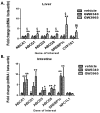Tissue-specific liver X receptor activation promotes macrophage reverse cholesterol transport in vivo
- PMID: 20110577
- PMCID: PMC3137455
- DOI: 10.1161/ATVBAHA.109.195693
Tissue-specific liver X receptor activation promotes macrophage reverse cholesterol transport in vivo
Abstract
Objective: We previously reported that a systemic liver X receptor (LXR) agonist promoted macrophage reverse-cholesterol transport (mRCT) in vivo. Because LXR are expressed in multiple tissues involved in RCT (macrophages, liver, intestine), we analyzed the effect of tissue-specific LXR agonism on mRCT.
Methods and results: In initial studies, the systemic LXR agonist GW3965 failed to promote mRCT in a setting in which LXR was expressed in macrophages but not in liver or intestine. To evaluate the effect of LXR activation specifically in small intestine on mRCT, wild-type mice were treated with either intestinal-specific LXR agonist (GW6340) or systemic LXR agonist (GW3965). Both GW3965 and GW6340 significantly promoted excretion of [(3)H]-sterol in feces by 162% and 52%, respectively. To evaluate the requirement for macrophage LXR activation, we assessed the ability of GW3965 to promote mRCT in wild-type mice using primary macrophages deficient in LXR alpha/beta vs wild-type macrophages. Whereas GW3965 treatment promoted fecal excretion compared with vehicle, its overall ability to promote mRCT was significantly attenuated using LXR alpha/beta knockout macrophages.
Conclusions: We demonstrate that intestinal-specific LXR agonism promotes macrophage RCT in vivo and that macrophage LXR itself plays an important, but not predominant, role in promoting RCT in response to an LXR agonist.
Figures





Similar articles
-
Liver X receptor activation promotes macrophage-to-feces reverse cholesterol transport in a dyslipidemic hamster model.J Lipid Res. 2010 Apr;51(4):763-70. doi: 10.1194/jlr.M001552. Epub 2009 Oct 27. J Lipid Res. 2010. PMID: 19965597 Free PMC article.
-
Pharmacological activation of liver X receptors promotes reverse cholesterol transport in vivo.Circulation. 2006 Jan 3;113(1):90-7. doi: 10.1161/CIRCULATIONAHA.105.560177. Epub 2005 Dec 19. Circulation. 2006. PMID: 16365197
-
Macrophage-independent regulation of reverse cholesterol transport by liver X receptors.Arterioscler Thromb Vasc Biol. 2014 Aug;34(8):1650-60. doi: 10.1161/ATVBAHA.114.303383. Epub 2014 Jun 19. Arterioscler Thromb Vasc Biol. 2014. PMID: 24947527 Free PMC article.
-
Liver X receptors (LXR) as therapeutic targets in dyslipidemia.Cardiovasc Ther. 2008 Winter;26(4):297-316. doi: 10.1111/j.1755-5922.2008.00062.x. Cardiovasc Ther. 2008. PMID: 19035881 Review.
-
Liver X receptor: a potential target in the treatment of atherosclerosis.Expert Opin Ther Targets. 2022 Jul;26(7):645-658. doi: 10.1080/14728222.2022.2117610. Epub 2022 Sep 5. Expert Opin Ther Targets. 2022. PMID: 36003057 Review.
Cited by
-
Role of the gut in lipid homeostasis.Physiol Rev. 2012 Jul;92(3):1061-85. doi: 10.1152/physrev.00019.2011. Physiol Rev. 2012. PMID: 22811425 Free PMC article. Review.
-
The oxysterol receptor LXRβ protects against DSS- and TNBS-induced colitis in mice.Mucosal Immunol. 2014 Nov;7(6):1416-28. doi: 10.1038/mi.2014.31. Epub 2014 May 7. Mucosal Immunol. 2014. PMID: 24803164
-
Liver X receptors in lipid metabolism: opportunities for drug discovery.Nat Rev Drug Discov. 2014 Jun;13(6):433-44. doi: 10.1038/nrd4280. Epub 2014 May 16. Nat Rev Drug Discov. 2014. PMID: 24833295 Review.
-
Novel HDL-directed pharmacotherapeutic strategies.Nat Rev Cardiol. 2011 May;8(5):266-77. doi: 10.1038/nrcardio.2010.200. Epub 2011 Jan 18. Nat Rev Cardiol. 2011. PMID: 21243009 Free PMC article. Review.
-
Oxysterols and their cellular effectors.Biomolecules. 2012 Feb 15;2(1):76-103. doi: 10.3390/biom2010076. Biomolecules. 2012. PMID: 24970128 Free PMC article.
References
-
- Tall AR, Yvan-Charvet L, Terasaka N, Pagler T, Wang N. HDL, ABC transporters, and cholesterol efflux: implications for the treatment of atherosclerosis. Cell Metab. 2008;7:365–375. - PubMed
-
- Repa JJ, Mangelsdorf DJ. The liver X receptor gene team: potential new players in atherosclerosis. Nat Med. 2002;8:1243–1248. - PubMed
-
- Repa JJ, Berge KE, Pomajzl C, Richardson JA, Hobbs H, Mangelsdorf DJ. Regulation of ATP-binding cassette sterol transporters ABCG5 and ABCG8 by the liver X receptors alpha and beta. J Biol Chem. 2002;277:18793–18800. - PubMed
Publication types
MeSH terms
Substances
Grants and funding
LinkOut - more resources
Full Text Sources
Other Literature Sources
Medical

